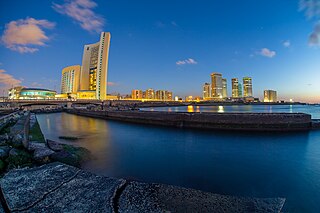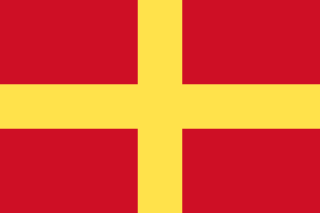Related Research Articles

Tripoli is the capital and largest city of Libya, with a population of about 1.18 million people in 2019. It is located in the northwest of Libya on the edge of the desert, on a point of rocky land projecting into the Mediterranean Sea and forming a bay. It includes the port of Tripoli and the country's largest commercial and manufacturing center. It is also the site of the University of Tripoli. The vast Bab al-Azizia barracks, which includes the former family estate of Muammar Gaddafi, is also located in the city. Colonel Gaddafi largely ruled the country from his residence in this barracks.

Kamal Haasan is an Indian actor, filmmaker, screenwriter, playback singer, television presenter and politician who works mainly in Tamil cinema. Besides Tamil, he has also appeared in some Malayalam, Hindi, Telugu, Kannada and Bengali films. He is considered to be one of the greatest actors in the history of Indian cinema. Haasan is also known for introducing many new technologies and cosmetics to the Indian film industry. He has won numerous accolades, including Four National Film Awards, Nine Tamil Nadu State Film Awards, Four Nandi Awards, One Rashtrapati Award, Two Filmfare Awards and 17 Filmfare Awards South. He was awarded the Kalaimamani Award in 1984, the Padma Shri in 1990, the Padma Bhushan in 2014 and the Ordre des Arts et des Lettres (Chevalier) in 2016.

The County of Tripoli (1102–1289) was the last of the Crusader states. It was founded in the Levant in the modern-day region of Tripoli, northern Lebanon and parts of western Syria. When the Frankish Crusaders – mostly southern French forces – captured the region in 1109, Bertrand of Toulouse became the first count of Tripoli as a vassal of King Baldwin I of Jerusalem. From that time, the rule of the county was decided not strictly by inheritance but by factors such as military force, favour and negotiation. In 1289 the County of Tripoli fell to Sultan Qalawun of the Muslim Mamluks of Cairo. The county was absorbed into Mamluk Egypt.

Tripoli is the largest city in northern Lebanon and the second-largest city in the country. Situated 81 km (50 mi) north of the capital Beirut, it is the capital of the North Governorate and the Tripoli District. Tripoli overlooks the eastern Mediterranean Sea, and it is the northernmost seaport in Lebanon. It holds a string of four small islands offshore. The Palm Islands were declared a protected area because of their status of haven for endangered loggerhead turtles, rare monk seals and migratory birds. Tripoli borders the city of El Mina, the port of the Tripoli District, which it is geographically conjoined with to form the greater Tripoli conurbation.

Krak des Chevaliers, is a medieval castle in Syria and one of the most important preserved medieval castles in the world. The site was first inhabited in the 11th century by Kurdish troops garrisoned there by the Mirdasids. In 1142 it was given by Raymond II, Count of Tripoli, to the order of the Knights Hospitaller. It remained in occupied by them until it was reconquered by the Muslims in 1271.

Raymond II was count of Tripoli from 1137 to 1152. He succeeded his father, Pons, Count of Tripoli, who was killed during a campaign that a commander from Damascus launched against Tripoli. Raymond accused the local Christians of betraying his father and invaded their villages in the Mount Lebanon area. He also had many of them tortured and executed. Raymond was captured during an invasion by Imad ad-Din Zengi, atabeg of Mosul, who gained the two important castles of Montferrand and Rafaniya in exchange for his release in the summer of 1137.

Tripoli is a city in the central part of the Peloponnese, in Greece. It is the capital of the Peloponnese region as well as of the regional unit of Arcadia. The homonym municipality has around 47,000 inhabitants.
Mustafa Kamal BS, better known as Shaheed Sipahi Mustafa Kamal was a sepoy in the Bangladesh Army during the Liberation War. He was born on 16 December 1947 in Hajipur village of Daulatkhan upazila under Bhola district. His father, Habibur Rahman was a Havilder. On 18 April 1971, Mustafa Kamal was killed in a defensive battle against the Pakistan Army in Daruin village of Brahmanbaria. He was posthumously awarded Bir Sreshtho.

The history of the Jews in Libya stretches back to the 3rd century BCE, when Cyrenaica was under Greek rule. The Jewish population of Libya, a part of the Sephardi-Maghrebi Jewish community continued to populate the area continuously until the modern times. During World War II, Libya's Jewish population was subjected to antisemitic laws by the Fascist Italian regime and deportations by Nazi German troops.

Ottoman Tripolitania, also known as the Regency of Tripoli, was officially ruled by the Ottoman Empire from 1551 to 1912. It corresponded roughly to the northern parts of modern-day Libya in historic Tripolitania and Cyrenaica. It was initially established as an Ottoman province ruled by a pasha (governor) in Tripoli who was appointed from Constantinople, though in practice it was semi-autonomous due to the power of the local Janissaries. From 1711 to 1835, the Karamanli dynasty ruled the province as a de facto hereditary monarchy while remaining under nominal Ottoman suzerainty. In 1835, the Ottomans reestablished direct control over the region until its annexation by Italy in 1912.

Asteras Tripolis Football Club, commonly referred to as Asteras Tripolis, is a Greek professional football club based in the city of Tripoli in Arcadia, Peloponnese, Greece. Founded on 26 March 1931,their badge has Theodoros Kolokotronis on his horse and they have yellow and blue worn as home kit. Its home ground is the Theodoros Kolokotronis Stadium, a 7,442-capacity stadium in Tripoli.
Lebanese Turkmen, also known as the Lebanese Turks, are people of Turkish ancestry that live in Lebanon. The historic rule of several Turkic dynasties in the region saw continuous Turkish migration waves to Lebanon during the Tulunid rule (868–905), Ikhshidid rule (935–969), Seljuk rule (1037–1194), Mamluk rule (1291–1515), and Ottoman rule (1516–1918).

Dragut, also known as "the Drawn Sword of Islam", was an Ottoman corsair, naval commander, governor, and noble. Under his command, the Ottoman Empire's maritime power was extended across North Africa. Recognized for his military genius, and as being among "the most dangerous" of corsairs, Dragut has been referred to as "the greatest pirate warrior of all time", "undoubtedly the most able of all the Turkish leaders", and "the uncrowned king of the Mediterranean". He was described by a French admiral as "a living chart of the Mediterranean, skillful enough on land to be compared to the finest generals of the time" and that "no one was more worthy than he to bear the name of king". Hayreddin Barbarossa, who was his mentor, stated that Dragut was ahead of him "both in fishing and bravery".

Ghazir is a town and municipality in the Keserwan District of the Keserwan-Jbeil Governorate of Lebanon. It is located 27 kilometres (17 mi) north of Beirut. It has an average elevation of 380 meters above sea level and a total land area of 542 hectares (2.09 sq mi).
The Assaf dynasty were a Sunni Muslim and ethnic Turkmen dynasty of chieftains based in the Keserwan region of Mount Lebanon in the 14th–16th centuries. They came to the area in 1306 after being assigned by the Bahri Mamluks to guard the coastal region between Beirut and Byblos and to check the power of the mostly Shia Muslim population at the time. During this period, they established their headquarters in Ghazir, which served as the Assafs' base throughout their rule.
Gibelacar, also known by its original Arabic name Hisn Ibn Akkar or its modern Arabic name Qal'at Akkar, is a fortress in the village of Akkar al-Atiqa in the Akkar Governorate in northern Lebanon. The fortress dates back to the Fatimid era in the early 11th century. It was captured and utilized by the Crusaders in the early 12th century until it was captured and strengthened by the Mamluks in the late 13th century. It became the headquarters of the Sayfa clan, whose members, chief among them Yusuf Pasha, served as the governors and tax farmers of the Tripoli Eyalet and its sanjaks from 1579 through the mid-17th century.

Tripoli, today the capital city of Libya, was ruled by the Knights Hospitaller between 1530 and 1551. The city had been under Spanish rule for two decades before it was granted as a fief to the Hospitallers in 1530 along with the islands of Malta and Gozo. The Hospitallers found it difficult to control both the city and the islands, and at times they proposed to either move their headquarters to Tripoli or to abandon and raze the city. Hospitaller rule over Tripoli ended in 1551 when the city was captured by the Ottoman Empire following a siege.
The Kisrawan campaigns were a series of Mamluk military expeditions against the mountaineers of the Kisrawan, as well as the neighboring areas of Byblos and the Jurd, in Mount Lebanon. The offensives were launched in 1292, 1300 and 1305. The mountaineers were Shia Muslim, Alawite, Maronite and Druze tribesmen who historically acted autonomously of any central authority. The Maronites in particular had maintained close cooperation with the last Crusader state, the County of Tripoli. After the fall of Tripoli to the Mamluks in 1289, the mountaineers would often block the coastal road between Tripoli and Beirut, prompting the first Mamluk expedition in 1292 under the viceroy of Egypt, Baydara. During that campaign, the Mamluks, spread along the coastal road and cut off from each other at various points, were constantly harried by the mountaineers, who confiscated their weapons, horses and money. Baydara withdrew his men only after paying off the mountain chiefs.
The Kisrawan or Keserwan is a region between Mount Lebanon and the Mediterranean coast, north of the Lebanese capital Beirut and south of the Ibrahim River. It is administered by the eponymous Keserwan District, part of the Keserwan-Jbeil Governorate.

This article lists historical events that occurred between 901–1000 in modern-day Lebanon or regarding its people.